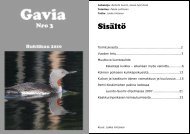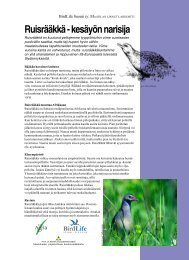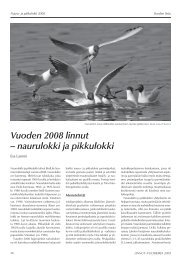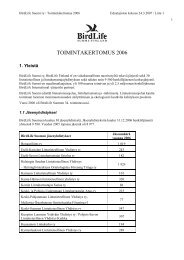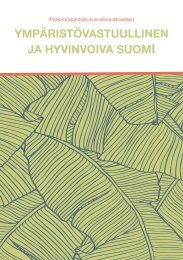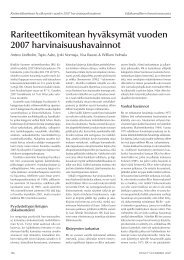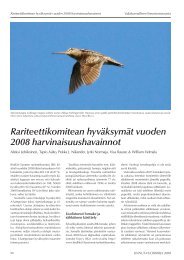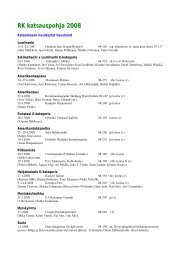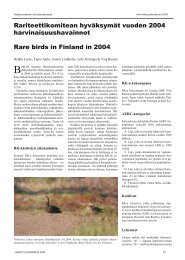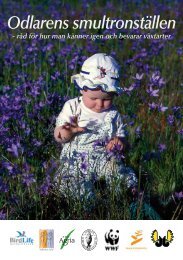Mackenzie, R. et al. 2001: Handbook of the Convention onBiological Diversity. Secretariat on the Convention onBiological Diversity, UNEP, UN. Earthscan PublicationsLtd.Maa- ja metsätalousministeriö 2002: Metsien suojelun luokittelunja tilastoinnin yhtenäistämistyöryhmä. -TyöryhmämuistioMMM 2002:15. Maa- ja metsätalousministeriö,HelsinkiMetsätalouden kehittämiskeskus Tapio <strong>2000</strong>: Talousmetsienluonnonhoidon laadun arviointi <strong>2000</strong>. Seurantaraportti.HelsinkiMetsätalouden kehittämiskeskus Tapio 2001. Hyvän metsänhoidonsuositukset. Libris Oy, HelsinkiMetsätalouden kehittämiskeskus Tapio 2002. Tapion taskukirja.Kustannusosakeyhtiö Metsälehti.Metsätalouden kehittämiskeskus Tapio 2003: Talousmetsienluonnonhoidon laadun arviointi: Tulokset 2002.www.metsavastaa.net 16.1.2003Metsäntutkimuslaitos 2002: Metsätilastollinen vuosikirja2002.Metsätalouden ympäristöohjelmatyöryhmä 1994. Metsätalousja ympäristö. Metsätalouden ympäristöohjelmatyöryhmänmietintö 1994:3. Maa- ja metsätalousministeriö,Helsinki.Pykälä, J. 2002. Vaateliaat jäkälät häviävät avainbiotoopeilta.Ympäristö 6, 25–26.Rassi, P., Alanen, A., Kanerva, T. & Mannerkoski, I. (toim.)2001: Suomen lajien uhanalaisuus <strong>2000</strong>. -Ympäristöministeriö& Suomen ympäristökeskus, Helsinki.Savola K., Hölttä, H. & Veistola T. 1999. Evaluation of theFinnish Natura <strong>2000</strong> proposal, Parts I & II. GeneralAssessment. <strong>BirdLife</strong> Finland, The Finnish Associationfor Nature Conservation, The Finnish Nature League,The Finnish Society for Nature and the Environment,WWF Finland. Edita, Helsinki.Siitonen, J., Martikainen, P., Punttila, P. & Rauh, J. <strong>2000</strong>.Coarse woody debris and stand characteristics in maturemanaged and old-growth boreal mesic forests insouthern Finland. Forest Ecology and Management128(3): 211–225.Siitonen, J., Penttilä, R. & Kotiranta, H. 2001. Coarse woodydebris, polyporous fungi and saproxylic insects in anold-growth spruce forest in Vodlozero National Park,Russian Karelia. Ecological Bulletins 49: 231–242.Syrjänen, K. 2001: Uhanalaisten ja luontodirektiivin kasvilajiensuotuisa suojelutaso suojelualueverkon kattavuudenarvioinnissa. Suomen ympäristö 501. Suomenympäristökeskus, Helsinki.Turunen et. al <strong>2000</strong>. Last of the last – old-growht forestsof northern Europe. The Finnish maps. Taiga RescueNetwork.Vanhojen metsien suojelutyöryhmä 1996. Vanhojen metsiensuojelu Pohjois-Suomessa. Vanhojen metsien suojelutyöryhmänosamietintö III. Suomen ympäristö 30,108 s. Ympäristöministeriö, Helsinki.Virkkala, R. 1996. Metsien suojelualueverkon rakenne ja kehittämistarpeet– ekologinen lähestymistapa. Suomenympäristö 16. Suomen ympäristökeskus, Helsinki.Virkkala, R., Korhonen, K.T., Haapanen, R. ja Aapala K.<strong>2000</strong>. Metsien ja soiden suojelutilanne metsä- ja suokasvillisuusvyöhykkeittäinvaltakunnan metsien 8. inventoinninperusteella. Suomen ympäristö 395. Suomenympäristökeskus ja Metsäntutkimuslaitos, Helsinki.Ympäristöministeriö 2003. www-sivut www.ymparisto.fi/luosuo/tyypit/paattaul.htm, 31.3.2003. Luonnonsuojelulainluontotyyppien kartoitus- ja suojelutilanne.Ympäristöministeriö <strong>2000</strong>: Metsien suojelun tarve Etelä-Suomessa ja Pohjanmaalla. Etelä-Suomen ja Pohjanmaanmetsien suojelun tarve – työryhmän mietintö.Suomen ympäristö 437: 1–283. Ympäristöministeriö,Helsinki.Östlund, L., Zackrisson, O & Axelsson, A.-L. 1997. The historyand transformation of a Scandinavian boreal forestlandscape since the 19th century. Canadian Journalof Forest Research 27: 1198–1206.Säädökset ja sopimukset:Luonnonsuojeluasetus 14.2.1997/160Luonnonsuojelulaki 20.12.1996/1096Metsäasetus 20.12.1996/1200Metsälaki 12.12.1996/1093Suomen perustuslaki 11.6.1999/731Bernin sopimus. Yleissopimus Euroopan luonnonvaraisenkasviston ja eläimistön sekä niiden elinympäristöjensuojelusta. Bern 19.9.1975. SopS 29/1986.Rion sopimus. Biologista monimuotoisuutta koskeva yleissopimus.Rio de Janeiro 5.6.1992. SopS 78/1994.54
Summary: Finnish forests and their protection statusby Sini HarkkiFinnish forests have been used for centuries, but the most significant changes in their characteroccurred with the advent of industrial forestry after World War II. Intensive forestmanagement together with the construction of forestry roads and drainage by extensiveditching have altered forests and bogs drastically. Together they have also caused a biodiversitycrisis to species unable to adapt to the altered conditions; in Finland forests holdmore threatened species than any other habitat type.Less than five percent of Finnish forests remain in a natural or semi-natural state, mostof them on state land in eastern and northern Finland. About half of these old-growthforests have been protected. Especially in southern Finland nearly all forests have been significantlyaltered by forest management and seldom offer suitable habitat for species requiringnatural forest conditions such as high levels of dead wood or relatively unfragmentedforest cover. As much as a fifth of Finnish forest species are dependent on dead wood forfood or shelter.Approximately 4,1 per cent of Finnish forest land has been protected from logging.”Forest land” is defined as land attaining tree growth of one cubic metre per hectare ormore annually. Most of these protected forests are situated in poorly productive areas innorthernmost Finland. In southern Finland all forest types need more protection (see figure5.8), while in northern Finland gaps in the protection network concern mainly old-growthforests important to species diversity, as well as some important for cultural heritage andlivelihoods such as reindeer herding. In northern Finland the forest protection networkcould still be improved with natural or semi-natural old-growth forests, whereas in southernFinland protection will need to be accompanied by widespread restoration works of habitatsalready heavily affected by forestry.Even a well-planned forest protection area network needs to be supplemented by measureswithin the surrounding commercial forests. Such measures were initiated in Finlandin the 1990s. The Nature Conservation and Forest Act were reformed in 1997, the latternow defining seven types of forest key habitats to be preserved when carrying out timberremoval. Some habitats worthy of inclusion were left out, however, and the law does notencourage retaining sufficient buffer zones around the key habitats (the average forest keyhabitat in Finland averages considerably less than one hectare in size). Also, a great numberof forest key habitats are still cut or damaged during logging operations. Forest managementguidelines have also been modernised to include e.g. recommendations on leaving retentiontrees when clearcutting, but recent research has questioned the ecological efficacy of thesemeasures.55



